This is a Nikon M 35mm rangefinder made by Nippon Kogaku starting in 1949. The Nikon M was the followup to the original Nikon rangefinder from a year earlier and was produced in very limited numbers. The “M” increased the exposed image size to 24mm x 34mm and increased frame spacing to allow for it to be compatible with Kodak slide mounts, but otherwise was the same camera. This was still an experimental time for Nippon Kogaku, so there are many subtle variances between different “M” models.
 Film Type: 135 (35mm)
Film Type: 135 (35mm)
Lens: 5cm f/2 Nikkor-H coated 6-elements
Lens Mount: Nikon S bayonet
Focus: 3 feet to Infinity
Viewfinder: Coincident Image Coupled Rangefinder
Shutter: Cloth Focal Plane
Speeds: T, B, 1 – 1/500 seconds
Exposure Meter: None
Battery: None
Flash Mount: Accessory Shoe only
Weight: 820 grams
Manual (Similar Model): http://www.cameramanuals.org/nikon_pdf/nikon_rangefinder.pdf
How these ratings work |
The Nikon M followed the original Nikon rangefinder and featured a few changes that Nippon Kogaku had hoped would make the camera more appealing to professional photographers such as a larger exposed image and standard frame spacing. A total of 1,649 Nikon Ms were ever made, making them quite rare. These are some of the earliest examples of cameras made by Nippon Kogaku shortly after World War II. Highly sought after by collectors for their rarity and historical significance, Nikon Ms are generally considered poor users as they lack many modern conveniences and refinements of later Nikon rangefinders. In my time with this camera, I found it’s poor reputation as a user to be unfounded as this camera was both a joy to use and created images as good as anything Nikon would release in the next decade. | ||||||
| Images | Handling | Features | Viewfinder | Feel & Beauty | History | Age | |
| 2 | 2 | 2 | 1 | 2 | 2 | 30% | |
| Bonus | none | ||||||
| Final Score | 14.3 | ||||||
History
This section will cover the history of the Nikon M rangefinder which was the successor to the original Nikon rangefinder released in 1948. I have previously written a comprehensive history on Nippon Kogaku in my review for the Nikon F which goes back all the way to Japan’s earliest days in the photography industry. I also cover early Nikon history in an article about David Douglas Duncan which includes information given to me by Nikon historian Robert Rotoloni. If you are interested in a more detailed history about Nippon Kogaku and Nikon cameras, I recommend reading both of those articles. For this one, I’ll start with the US occupation of Japan right after the end of World War II.
After Japan’s surrender in World War II in August 1945, American forces would shut down nearly all Japanese industry, including most of Nippon Kogaku’s factories that weren’t completely destroyed during the war. Some sources say that before the war, there were anywhere between 19 and 26 factories in total. Regardless of the number, during the period of American occupation in Japan, all military and weapons related manufacturing was prohibited.
General Douglas MacArthur was in charge of operations to assess future Japanese potential for post war prosperity. Even before the war, the United States saw great potential in Eastern Asia and had established many military bases in and around the far East. Part of the reason for Japan’s entry into World War II was to stop the US advance of military supremacy in the Philippines, Korea, Guam, and other island nations. Maintaining a stronghold in the east was still a priority after the war, so the United States had a stake in turning Japan into an ally and rebuilding their economy to help boost US strength in this region.
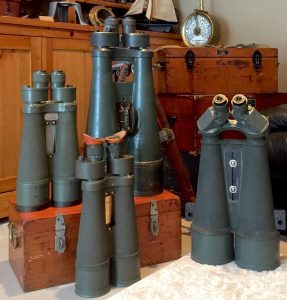
Nippon Kogaku had made nearly all of Japan’s optical products during the war, such as binoculars, scopes, gun sights, and had amassed a large workforce of very talented engineers and laborers. After the war, the US surveyed Nippon Kogaku’s potential for economic growth and decided that they had the right amount of potential to help kick start the Japanese economy.
Up until this point, with the sole exception of it’s partnership making lenses and the rangefinder for the Hansa Canon in the 1930s, Nippon Kogaku had absolutely no experience producing and marketing products for the civilian market. Despite this lack of experience, the company’s many skilled workers were asked to come up with a list of viable products the company could make and sell.

In total, a list of 38 products were selected as viable designs that could be made and sold. A variety of camera lenses, binoculars, telescopes, microscopes, spectrographs, and cameras would soon roll out of Nippon Kogaku factories.
The first product to resume production was a line of quality binoculars that Nippon Kogaku had made during the war. These binoculars were superior to other designs used by the American military, and upon capture of Japanese war ships, became highly sought after trophies for soldiers. Nippon Kogaku’s binoculars were seen as world class products, so it made sense to produce a commercialized version of these binoculars.
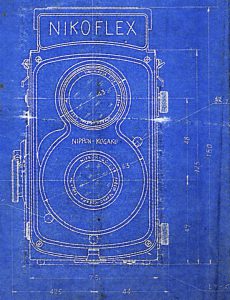
In April 1946, Nippon Kogaku announced the development of two new camera designs, the first was an 80mm Twin Lens Reflex camera called the Nikoflex that was said to have an automatic film advance, a high quality leaf shutter, and Nippon Kogaku’s best Nikkor lenses. The best leaf shutters in the world at this time were made in Germany, which was also devastated after the war, so Nippon Kogaku set out to design their own leaf shutter, but it was decided quickly that such an undertaking would be prohibitively expensive. Only a few Nikoflex prototypes were ever built, and none are known to survive. Instead, the company decided to focus all of it’s efforts on a compact 35mm rangefinder with an interchangeable lens mount.
During the summer of 1946, Nippon Kogaku worked tirelessly on their new 35mm compact rangefinder. It went through several name changes, one of which was the Nikkorette, but in September 1946 when the first prototypes were produced, the name Nikon was chosen instead as a shortened version of the company’s name.
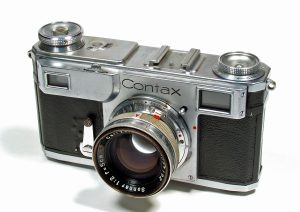
Not content to follow in the footsteps of other Japanese camera companies and design another Leica inspired rangefinder, Nippon Kogaku instead used both the Zeiss-Ikon Contax II rangefinder and the Leica II as the basis for their new camera. It is said that Nippon Kogaku thought that neither the Contax or the Leica were perfect, and decided to take the best of both cameras and make their own. The new Nikon camera would share a lot of cosmetic similarities to the Contax, including the top focus wheel, removable film back, and a slightly modified bayonet lens mount. Nippon Kogaku chose a bayonet mount instead of the Leica’s screw mount as it was faster to attach and detach, but also offered a more secure connection to the camera.
From Leica, the Nikon would share it’s simpler rangefinder and shutter designs. Rather than the vertically traveling “garage door” focal plane shutter of the Contax, the Leica’s horizontally traveling cloth shutter was chosen to both keep costs down and to improve reliability of the camera.
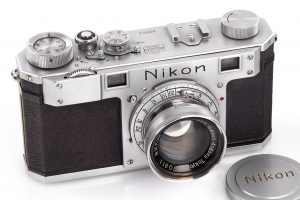
Although the initial design for Nikon’s new camera was completed in the fall of 1946, Nippon Kogaku would wait until March of 1948 to officially offer it for sale. Despite being very well built and innovative in design, the original Nikon (now known as the Nikon I or Nikon One by collectors) did not sell well.
In these early days, it was Nikkor lenses that attracted the most attention, and not Nikon cameras. LIFE magazine photographers like David Douglas Duncan, Carl Mydans, and Horace Bristol were some of the first elite photographers to proclaim the superiority of Nikkor lenses over those made in Germany. Nikon cameras attracted far less attention, but for those like San Francisco based distributor Adolph Gasser, and New York based camera repairman Marty Forscher, they marveled and the new Japanese camera. They appreciated the combination of what was considered the best of Contax and Leica in the same camera. Their biggest complaint however, was in the smaller 24mm x 32mm “Japanese size” exposures because they wouldn’t fit within standard 24×36 slide film holders.
The reason for the smaller negative is attributed to a variety of reasons. For one, film was extremely expensive in post war Japan, so the idea that you could eek out a few extra exposures by using a smaller negative might have appealed to Japanese photographers. Second, it was believed that with a 24×32 negative, the aspect ratio of 1.33:1 was more pleasing and more similar to the 1.375:1 Academy Ratio standardized by the early motion picture industry, and the 4:3 aspect ratio of early televisions. The third, and perhaps the real reason, is that in order to fit the horizontally traveling shutter inside the body of the Nikon rangefinder, a standard 24x36mm film gate simply wouldn’t fit. According to Robert Rotoloni, even after Nippon Kogaku redesigned the later Nikons, the film gate was still only 35.5mm wide.

It is estimated that only 750 Nikon Is were made, but only 400-500 were ever sold. Based on feedback from various American photographers who had taken a chance on the earliest cameras, Nippon Kogaku decided to modify the camera to increase the exposed image to a (still not standard) 24mm x 34mm frame, and change the frame spacing to accommodate a 36mm frame spacing. Although the exposed image would only be 34mm wide, the camera would leave a larger gap between images so that the film could be cut and fit into standard slide holders. Looking at an exposed strip of film shot in a Nikon M, you can very easily see a larger gap between the exposures. In the image to the right, I show a strip of film shot in a modern 35mm camera compared to a strip shot in this Nikon M. Notice that although the images are spaced the same, the gap between the images on the bottom is larger.
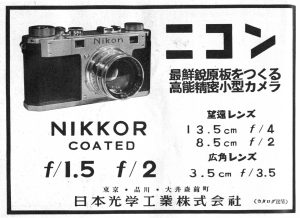
A total of 1,649 Nikon Ms were produced, outselling the original model by more than triple, but it was hardly a runaway success. A lack of familiarity and also the high price meant it was out of reach from all but professional photographers. I could not find a retail price of the Nikon M while it was in production, but according to these scans of two different price lists both from 1952, a Nikon S rangefinder with the 5cm f/2 lens seen on the example being reviewed here would have been $259. To have the faster f/1.4 lens which was not available for the original Nikon M, you had to fork over another $90. When adjusted for inflation that’s like paying $2422 and $3264 today!
It wasn’t until the midst of the Korean War when American press photographers caught wind of a new Japanese camera that had superior optics and build quality to German cameras, that the Nikon became known outside of Japan. One of the many reasons Nippon Kogaku has been so successful over the past century is their willingness to listen to their users and adapt. The Nikon M would eventually be replaced by the S, then the S2, and then the SP, each improving on the earlier models. Features like a flash sync, lever wind, easier film loading, variable viewfinder frame lines, and titanium curtains would eventually appear on later models helping to cement the Nikon rangefinder as one of the world’s premiere cameras.
Today, all Nikon rangefinders are highly sought after by users and collectors alike. In 2000 and 2005, Nikon would reproduce modern special editions of the Nikon S3 and SP respectively for collectors, painstakingly recreating nearly every detail of the original cameras using all new materials. These cameras were produced in small numbers and are worth a fortune today.
Of the original models, the SP is probably the most sought after for those who want to use them, followed by the S3, and S4, and then from there the S2, and original models. From a collectability standpoint, the rarer the model, the more expensive it’s going to be. So while these cameras are often out of reach of budget minded collectors such as myself, if you keep your eyes peeled, deals will still come along. If you happen to come across an original M or S model don’t immediately assume it’s an inferior camera to the later ones. ALL Nikon rangefinder cameras were well built and fantastic users…if they work.
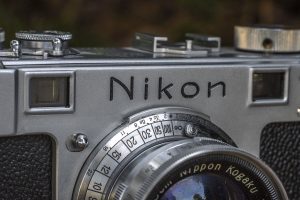
My Thoughts
The story of how I came in possession of not one, but two Nikon M rangefinders is probably a whole post in of itself, but it started out with an email from a San Francisco based photographer named Giselle Brewton who had recently come across a non-functioning Nikon M and wanted my advice on how to evaluate the camera for authenticity and value. I suggested she send it to me and I could show it to Nikon historian Robert Rotoloni and get his thoughts on it.
Giselle trustingly packaged up her Nikon M and sent it to me, and upon it’s arrival I gave Robert a call and said I had something for him to look at and I scheduled a time where I could visit him and discuss the camera.
When I brought the Nikon M over to Robert, he inspected it and told me this wasn’t just any Nikon M, it was one of the approximate 250 Nikon I’s that were never sold and modified by Nippon Kogaku to Nikon M specifications. The film gate was increased from 32mm to 34mm, the sprockets were changed, and so was the film back. The easiest way to tell a modified Nikon M from one that was built that way, is that the stamped “M” in the serial number is a darker color and spaced farther away from the rest of the serial number.
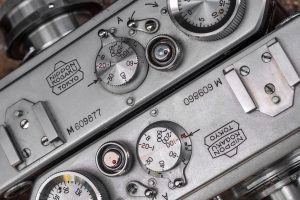
Amazingly, Robert had another camera like this one, with a serial number that was only 17 digits earlier. In the image to the right you can see both serial numbers M 609860 and M 609877 together, for probably the first time since they rolled off the assembly line almost 70 years ago!
Although both cameras were in spectacular cosmetic condition, Giselle’s had an inoperative shutter, which Robert said was very common. Nikon was still experimenting with what worked and what didn’t in the first few years of making cameras. In the 30 years prior to the first Nikon rangefinder, they had never produced their own camera, so this was all uncharted territory for them. As a result, there are minor differences between these early Nikons during their production run which affected their reliability.
Fortunately, Robert’s camera worked well, so I asked very nicely if I could borrow his and shoot a roll through it to which he agreed. Having previously shot a Nikon S2 and reading that it was superior in use to the earlier Nikon rangefinders, I had low expectations of the M. After all, the M is nearly identical in use to the original Nikon I, and those are generally regarded as not as nice to use as later models.

Almost immediately after handling both Ms it became clear to me that Nikon was already on the right track when they made these early cameras as they have an excellent feel. The camera is heavy and very solid, almost like a compact metal brick. The fit and finish of the camera is superb, with no play whatsoever in any of the moving parts. The back of the camera removes easily and does not wobble or indicate any sort of fit or finish problem.
The Nikon M uses a real leather body covering which means that nearly all of them develop “Zeiss Bumps” which is a type of corrosion commonly seen on leather covered cameras where chemicals used in the glue to attach the leather, interact with brass rivets in the body causing a bump to appear in them. You can see these bumps on both cameras on the front and back. Starting with the S2, Nippon Kogaku switched to a synthetic body covering which was not only more durable, but won’t exhibit these types of bumps. Zeiss bumps rarely hurt the value of the camera, and to many collectors add to the authenticity of an old camera.
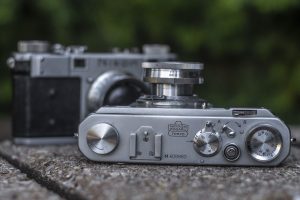
The top of the camera is a bit cluttered, but everything serves a purpose. From left to right is the rewind knob, accessory shoe, two-piece shutter speed selector, shutter release, advance/rewind lever, and combined film advance knob and exposure counter. The lack of a flip up rewind knob or lever advance would not have been seen as ‘cons’ to the camera upon it’s release as these features were still a couple of years away from being standard fare. Another difference between converted Ms like this one and later ones, is that the these cameras do not have any sort of flash sync.
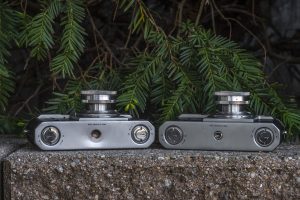
As with all Nikon rangefinders, the entire back and bottom of the camera are removable. Prior to the S2, Nikon rangefinders had dual locks on each side of the bottom plate that needed to be swiveled from “Shut” to “Open” before the back could be removed. With the release of the S2, Nippon Kogaku switched to a single lock back. In the image to the left, you can see the camera on the left has a larger “European” 3/8 inch sized tripod socket, and the one on the right has some sort of adapter inside of the hole to accommodate smaller 1/4 inch tripods. Whether this adapter was installed from the factory or added later by a previous owner is unknown.
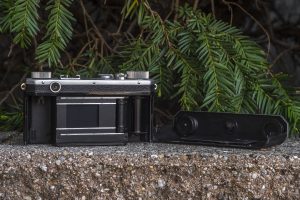
Loading film into the Nikon is just like any other modern camera, which is because most modern cameras took their design from the Nikon F from 1959, and the Nikon F was based off the Nikon rangefinder. So, by association, all modern cameras have at least something in common with the Nikon M. A new cassette of film loads on the left. You stretch the leader across the film plane, over the sprockets, and attach it to the take up spool. The only real difference here is that the back is completely removable, instead of hinged. Simple!
One of the best features Nippon Kogaku “borrowed” from the Zeiss Contax was it’s bayonet lens mount. Nikon’s mount is essentially the same as Zeiss’s but there is a minor difference in the pitch of the focus threads. This causes a focusing error when using Contax lenses on Nikon rangefinders that progressively gets worse the farther from infinity you attempt to focus. On the standard 5cm primes and wide angle lenses, this error isn’t really noticeable except on closeups, but it causes a problem on longer lenses like the 8.5cm and 10.5cm telephoto lenses. There is some incorrect info on the Internet that suggests it is due to something called “nominal focal length”, but according to Robert, the proper explanation is far simpler, which is that Nikon simply used a different thread pitch in their mount than Contax did. The difference is very small, but enough to affect the image in certain situations.
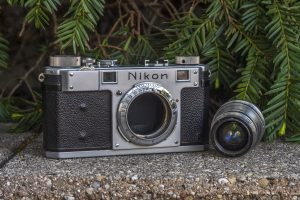
Swapping lenses on the Nikon M is very simple, just a gentle press of a lock pin near the 12 o’clock position and a quick twist of the lens and it’s off. The Contax and Nikon mount is actually a dual mount in which most 5cm lenses mount inside of camera (the ultra-rare 5cm f/1.1 lens uses the external mount), showing an engraved focus scale around the perimeter. For all wide angle, telephoto, and bellows applications, there is an external mount around the outer edge that lenses can be attached to. This external claw allows not only for the focus scale to change, but also increases strength of the mount for heavier lenses.
In use, the Nikon M feels like most other Japanese rangefinders made during the middle part of the 20th century. Compared to later Nikon rangefinders like the Nikon S2 which I have previously reviewed, the Nikon M is equally heavy and feels great in your hands. Tactile changes such as a knob film advance and knob rewind do slow down the shooting process, but really don’t get in the way as much as you’d expect. For people who might have needed to shoot multiple exposures in rapid succession, the lack of a lever wind would be an issue, but with a nearly 70 year old camera that has never been serviced (at least not during the time Robert has owned it), it’s probably not a good idea to rapid fire the shutter, so there was never a point where the knob wind became an issue for me.
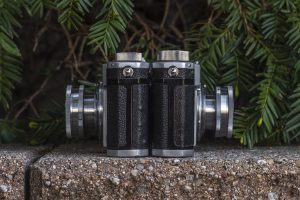
Where I expected there to be a significant difference was in the viewfinder. Where the Nikon S2 has a large and bright viewfinder with projected frame lines and an easy to see coincident image rangefinder patch, the Nikon M’s viewfinder is much smaller and has no frame lines. The only thing visible in the viewfinder is the rectangular rangefinder patch.
Amazingly, I had no issue composing my images or focusing the camera. Robert’s M had an ever so slight vertical alignment issue, but the more important horizontal axis was spot on. Despite wearing prescription glasses, I never had a problem seeing the entire image. I was pleasantly surprised at how easy it was to use this camera. I still prefer the one in the S2 over this, but I’ve seen much worse viewfinders and rangefinders on cameras both older and newer than this. Sadly, while I had these cameras in my possession, I never thought to capture a ‘through the viewfinder shot’, but there’s really not much to see.
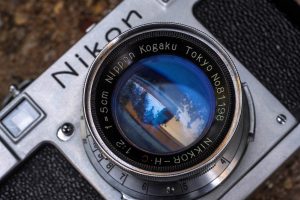
The lens has Nikon’s early coating which gives off a nice blue tint and does a good job of faithfully reproducing colors and improving contrast in most images. These coatings were one of the reasons that Nikkor lenses were a step up from the German competition, and one of the things that appealed to early photographers who used them.
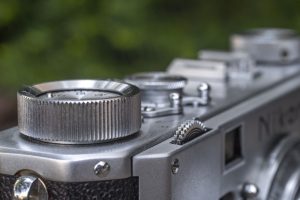
Adjusting focus can be accomplished simply by turning the main part of the lens, or by using the knurled focus wheel on the top plate of the camera in front of the shutter release. As with Contax rangefinders, the Nikon has a focus lock when the camera reaches infinity. When this lock is engaged, you cannot move the focus away from infinity until you press down on the knurled wheel on top of the camera. The focus scale on the Nikon M stops at f/2 whereas later Nikon rangefinders stop at f/1.4.
The more I handled the Nikon M, the more I saw this as a high quality optical instrument, just as I have their later models like the S2 and SP. The things I had read that the earlier models weren’t good users didn’t seem to be valid. The build quality of the body was great, the viewfinder wasn’t nearly as bad as I had thought it would be, and if the optics of the Nikkor lenses lived up to their reputation, this should be one heck of a camera. I am frankly surprised that more photographers didn’t take more notice to these earlier cameras as I think they were quite good! Of course, I hadn’t yet used the camera with film in it, so maybe my opinion might change…
My Results
For what would likely be the first roll shot through this Nikon M in probably decades, I decided to play it safe and I loaded in a fresh roll of Fuji 200 and shot it around my house. Considering the rarity and value of this camera (roughly 250 of these converted Nikon Ms exist) I wanted to make sure it was never in an environment where it could get banged around or damaged. As much as I thoroughly enjoyed both cameras, I wanted to get them back to their original owners as soon as possible.
Knowing what to expect from a Nikkor lens, I figured the images would come out nice, and they were. What impressed me the most, was how well this camera had held up over time. There were no major light leaks, the shutter worked close enough to the correct speed that shooting a roll of 200 speed color film using Sunny 16 was easy.
My compositions likely aren’t going to win me any contests (nor would I try), but that’s more of a side effect of a rush job trying not to stress a rare camera and get it back to it’s owner.
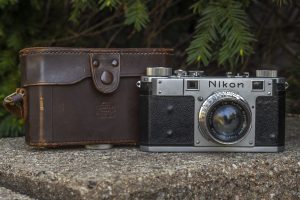
What I learned from my time with both Nikon Ms is that despite what you commonly read online, these early Nikons are great shooters too. The serial number on this Nikon M suggests it was one of the first 600 ever made by Nippon Kogaku. When this camera was made, the majority of the photographic world had never heard the name Nikon before. Japanese photographers used German cameras and lenses just like everyone else. The story of these cameras is a true underdog story and today we have the benefit of hindsight to see the level of success Nippon Kogaku would have, but it’s clear that they were definitely on the right track in their earliest days of making cameras.
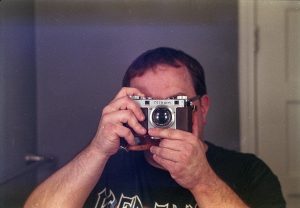
Robert warns though, that finding another Nikon M in good working condition like this one will be very difficult. Not only can the perils of 70 years cause these cameras to develop issues, Nippon Kogaku was still getting feeling their way around making a camera. Shutter curtain materials were sourced from at least 3 different companies, the leatherette covering that they used was later replaced with a more durable material, and the lenses and bodies were hand made. Robert said that there was no mold to which the rear film door could be cast for a perfect fit. In order to ensure that a door was properly fit to the rest of the body, the door channels were chiseled out by hand and hammered to fit perfectly to a matched body until it was right. No two doors of an early Nikon rangefinder are identical and it is critical that when purchasing one of these early cameras, to match the serial number on the door to the body. If they don’t match, there is a good chance that it won’t fit correctly.
Each of these cameras have endured many years of dirt, dust, grime, vibrations, bumps, scratches, moisture, dryness, and any other condition things that will hamper their reliability. If you acquire a camera and would like it to be a reliable shooter, you’ll have to get it serviced by a professional to maintain proper operation. If you do though, you’ll be rewarded with a surprisingly good and fun to use camera that absolutely deserves the reputation it, and later models have earned in the last century!
Additional Resources
http://www.mir.com.my/rb/photography/companies/nikon/htmls/models/htmls/nikon1_S.htm
https://imaging.nikon.com/history/chronicle/rhnc09s-e/
https://www.cameraquest.com/nrfmnosy.htm

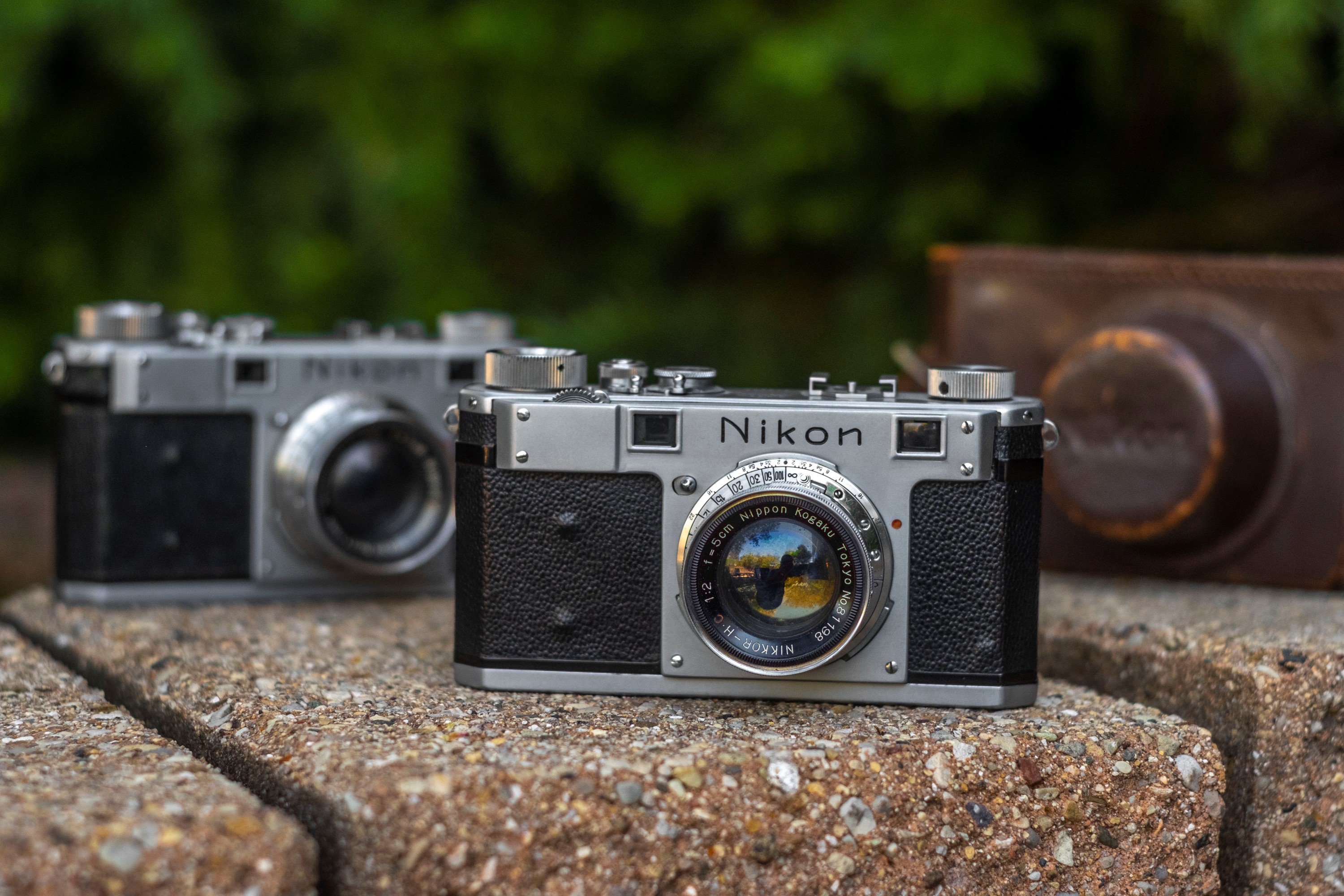
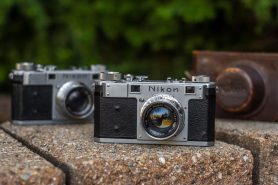















Great article!
have a sn# M 6092414 and can not figure value as sn does not follow what i have read. help.
Your camera is likely a Model MS with the sync ports on the side. These cameras were produced from about M 6091958 to about M 6094125 but Nippon Kogaku did not produce cameras in exact numerical order so those numbers are just best estimates.
thanks for the response, no sync ports and does have made in occupied japan stamped on the leather back cover and sn on cover and camera match. any estimate on value or not worth perusing
Great review! Enjoyed the history behind it too!
You’ve been remarkably thorough in your review, and yet readable all the way through. I’m ashamed to say I pawned my Nikon S3 when I was broke in my mid-twenties and have kicked myself over it forever since. My loss was someone’s big gain! Nikon rangefinders are gorgeous instruments and the manner of using a rangefinder, with no internal meter, no autofocus, only a tiny window in which to gauge focus, and the ability to see beyond the frame in the viewfinder is the most wonderful way to truly learn photography. I truly appreciate the generosity of your post; and your shot of the boy at the bay window is a great example of the gentleness of rangefinder photography – your presence and the soft click of the shutter do nothing to disturb his summer reverie.
I thoroughly enjoyed the artice. Extremely well written and obviously well researched. Some of this I’ve read before in varying degrees of detail. This may be the first time I read that Nikon conciously wanted the best of both worlds. I often took this as more of an an observation than a planned execution. Which brings me to my first surprise. In describing the frame size you report that they couldn’t fit the horizontal shutter with the wider frame size. This seem to imply they fixed their dimension on the vertically traveling Contax?? and then “Oh no …the body’s not long enough”… I find it hard to believe they painted themselves in to a corner.?
The second surprise is similar in concept. The known slight in-compatibility between Contax and Nikon lenses. The argument was they already had the Leica/Canon lenses from earlier. The difference was in the “helical or pitch. Gandy says as much, but also mentions the construction tolerances of focal lenths stating a .8mm difference. IS this cause vs effect? They had the choice (again I can’t see them conciously saying “Oh no now we can’t use Zeiss lenses” ) They later released the longer focal length lenses marked “C” for use with Contax. So I think they conciously accepted this; understanding there would be nominal optical differences in normal use.
Chuck, thanks for the kind words! As you’ve seen, there is some conflicting information out there on the Internet (understatement of the year), but most of the info from this article came from my chats with Nikon historian Robert Rotoloni.
In regards to the smaller exposure size of the Nikon rangefinder, it’s worth noting that other Japanese camera makers also embraced a smaller 24mm x 32mm size. The original Minolta 35 also shot images in this size. I don’t have conclusive evidence of this, but I believe the Japanese found this size to be more visually appealing. Of course we know that they eventually changed this, first to 24mm x 34mm, but according to Bob even in the final Nikon S2, SP, S3, and S4s, the film gate is actually 24mm x 35.5mm as a full 36mm just wasn’t possible. Remember the original Zeiss Contax design had the curtains above and below the film gate, not to the side. There was limited space to fit a Leica style horizontally traveling shutter on the sides of the film gate, while still retaining the same basic shape as the Contax.
Why Nikon couldn’t have just redesigned the camera to make more room, keep in mind that Nippon Kogaku was still a very small company back then. They had very finite resources and simply couldn’t take on a whole new redesign in the mid 1950s, especially while they were still playing catch up to the Germans and other Japanese companies like Canon were hot on their heels. Robert talks about compromises in the Nikon F design because the beancounters wouldn’t allow the designers to make an entirely new SLR from the ground up. Their upcoming Nikon F SLR was required to share as many parts as possible with the rangefinder as they didn’t have the resources to make an entirely new camera. If you’ve ever wondered why Nikon seemed to suddenly give up on the rangefinder so quickly after the Nikon F was released, when other Japanese companies like Canon and Minolta continued to make rangefinders well over a decade later, it was due to Nikon’s inability to produce Nikon F’s fast enough while still making the rangefinder. In fact, Joseph Ehrenreich, who was one of the dominant importers who helped popularize Nikon in the United States, demanded that if Nikon couldn’t keep up with demand for the Nikon F, that they discontinue the rangefinder in order to increase capacity.
In regards to the differences between Nikon and Contax lenses, Robert explained that right after the war, American photographers in Japan almost exclusively used Leicas, so Nippon Kogaku prioritized lens making in the M39 screw mount. Nikon’s decision to make it’s own camera with the Contax mount came later. In fact, there was a plan to make the Nikon rangefinder using the M39 mount, and even a few prototypes were built, but never went into wide scale production.
Nippon Kogaku realized that demand for their own camera might not be there, and that it made more financial sense to keep making lenses in the Leica mount in case their camera didn’t succeed, and since making dedicated Contax lenses would have required a change, they simply just did everything to Leica specifications. Due to the extremely minimal differences at 50mm and wider, there was no need to make Contax specific lenses, but as you noted, for the telephoto lenses, they did make “C” versions specifically for Contax.
Wonderful read. I recently picked one up, I was wondering what I can learn from the serial number M6094034
William, glad to hear you are now a member of the Nikon M club! I don’t have a lot of knowledge in decoding Nikon rangefinder serial numbers, but all I can tell you is that yours being a 7-digit number means it’s a later M, made probably right before the Nikon S made it debut.
Hello, I’m enjoying your articles! I know Ken Rockwell has an article ranting about 8-perf versus 7-perf 35mm and it’s an issue that hasn’t been talked about here, that of printing to photo paper. I tend to agree with him (and Nikon) on this as I’ve spent a lot of time in the last year and a half printing in the darkroom. Standard paper aspect ratio is 1.25:1 so if your film frame is 1.32:1 that will fit so much more uniformly on a standard 8×10 print. With the 8-perf 1.5:1 frame you’re either cropping a significant portion of your image when printing (my usual MO) or you’re going to have to print smaller which means uneven (and unsightly) borders like my Intro to Photography instructor made us do, or you’re cutting paper to a non-standard size (which I tried about a year ago). None of these options offers an ideal solution and I’m not really worrying about this in the heat of the moment so quite a few of my compositions are filled, no room for cropping. I wish that the 7-perf frame had become the standard because there would be so much less wasted paper AND film. I’m surprised it took as long as it did for a camera company to make a 7-perf frame and disappointed that it never took off.
Thanks for the feedback Joe. You’re right, I don’t spend a lot of time in the article talking about the different exposure sizes that Nippon Kogaku used early on, but it’s worth mentioning that the original Nikon I shot 24mm x 32mm images across 7 sprockets. This reduction in size allowed for a few extra exposures per roll (around 40 on a 36 exp roll). With the Nikon M that I reviewed, the film gate width was increased to 34mm wide, but still not quite the 36mm width of most other cameras. Despite shooting a smaller than 36mm wide image, the Nikon M used 8 sprockets instead of 7, meaning you didn’t benefit from extra exposures on the roll, and you just had thicker gaps between the exposures, which I show in the article.
There were a few other companies that also did 24mm x 32mm images, one of which was Minolta. Their earliest interchangeable lens rangefinders also shot that same size. I am sure there are others too, but off the top of my head I can’t remember who.
Just came across a Nikon that has a serial number on top 60910967. Is this a Nikon M? Very informative web page. I enjoy all the historical content!! Thank you!
Mike, thanks for the compliments! Your Nikon rangefinder is a type II Nikon S, it is not an M. All M’s would have the letter M in front of the serial number and a 7 digit serial number.